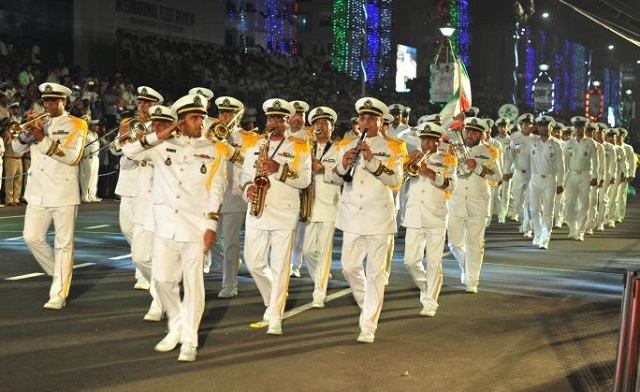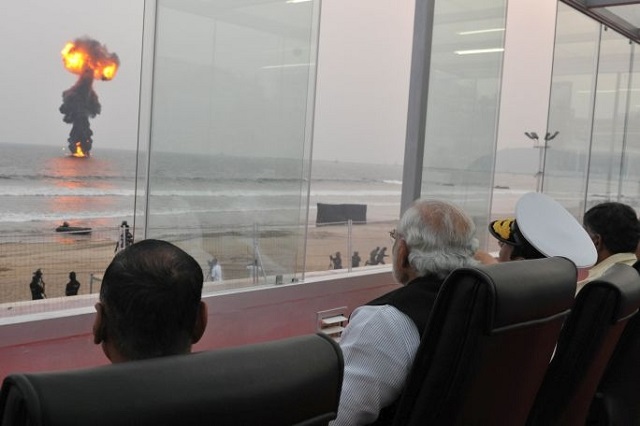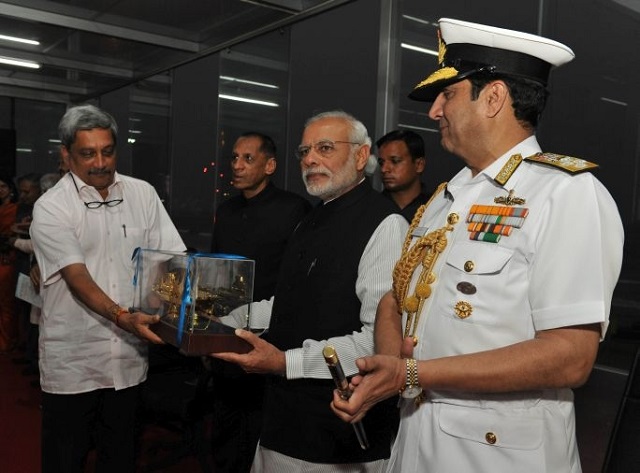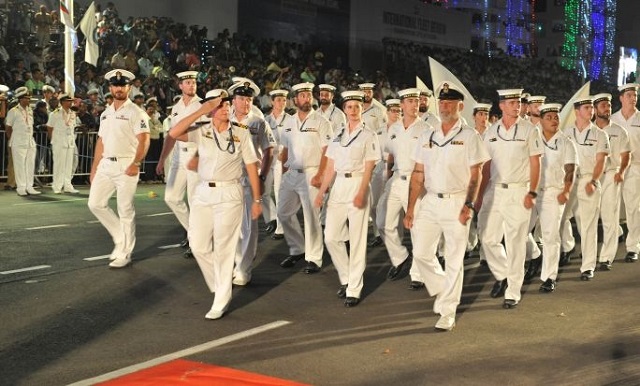Watch: International Fleet Review 2016
India’s Prime Minister Narendra Modi delivered a message of international cooperation at the 2016 International Fleet Review in India. India hosted the International Fleet Review at Visakhapatnam from February 4-8. 75 warships from 24 countries joined the review including Australia, China, Indonesia, Malaysia, the United Kingdom, France and Japan.
Extract from Modi’s speech
The oceans and world’s waterways are global commons. Vasudhaiva Kutumbakam– the concept of whole world as a family – is perhaps most vividly witnessed on the oceans of the planet, that connect us all.
The last time India hosted the International Fleet Review was in the year 2001, in the city of Mumbai. The world of 2016 is vastly different. Its politics is turbulent, and its challenges complex.
At the same time, the oceans are the lifelines of global prosperity. They present us with great economic opportunities to build our nations.
Over 90 percent of global merchandise trade is carried on the oceans. Over the last 15 years, its value has grown from about six trillion dollars to about 20 trillion dollars.
Oceans are critical for the global energy security as over 60 percent of world’s oil production moves through sea routes. Our ability to reap economic benefits from the oceans rests on our capacity to respond to the challenges in the maritime domain.
The threat of sea borne terror, of which India has been a direct victim, continues to endanger the regional and global peace and stability. Piracy too remains a strong challenge. The threat of natural disasters like tsunamis and cyclones is ever present. Manmade problems such as oil spills, climate change continue to risk the stability of the maritime domain.
A peaceful and stable maritime environment is, therefore, critical for the regional and global security. It is also a must to harvest the riches of the oceanic ecosystems.
Given the scale and complexity of modern day challenges, the international maritime stability cannot be the preserve of a single nation. It has to be a shared goal and responsibility of all the seafaring countries. To this end, the Navies and maritime agencies of the world need to work together, and engineer virtuous cycles of cooperation. But, where necessary, they also need to act to secure the international sea lanes of communication.
I believe that if oceans were to propel our economies, then we must:
• Use seas to build peace, friendship and trust, and curb conflict;
• respect and ensure freedom of navigation; and
• cooperate, not compete in responding to the challenges in the seas.
The large presence of foreign Navies at this Fleet Review is a confirmation of our shared urge to walk the pathways of peace and cooperation to keep the maritime domain safe and secure.
Friends, India is, and has always been, a maritime nation. India's ancient Sanskrit texts also refer to the oceans as the storehouse of Chaturdashanam Ratnanam, the 14 gems. Surrounded by sea from three sides, India has a long coastline of over 7500 kilometres. We have been blessed with a rich maritime heritage ever since Lothal in Gujarat became one of the earliest sea ports of the world.
India’s central location in the Indian Ocean has connected us with other cultures, shaped our maritime trade routes, influenced India’s strategic thought, and defined our maritime character. Since the days of the Indus Valley Civilization, India has maintained an extensive network of maritime links, including with Africa, Western Asia, the Mediterranean region, the West, South East Asia and the Far East.
We are delighted that the Navies from all these regions have joined in this Fleet Review.
In modern times too, the oceans, especially the Indian Ocean, occupy a vital place in India’s national security and economic prosperity. The waters of the Indian Ocean touch the shores of over 40 countries. About half of world's container traffic; and close to one-third of world's cargo traffic passes through this region. 90 percent of our trade by volume and 90 percent of our oil imports are carried on the seas.
India’s 1,200 island territories and our huge Exclusive Economic Zone of 2.4 million square kilometers makes clear the economic significance of the Indian Ocean. For us, it also serves as a strategic bridge with the nations in our immediate and extended maritime neighborhood.
In March last year, in Mauritius, I had spelt out our vision for the Indian Ocean. The Indian Ocean Region is one of my foremost policy priorities. Our approach is evident in our vision of “sagar”, which means “ocean” and stands for – Security And Growth for All in the Region. We would continue to actively pursue and promote our geo-political, strategic and economic interests on the seas, in particular the Indian Ocean.
To this end, India's modern and multi-dimensional Navy leads from the front. It is a force for peace and good. A network of growing political and economic maritime partnerships, and strengthening of regional frameworks also helps us pursue our goals. India’s quest for economic prosperity through oceans is a part of our larger efforts to transform India. We are not just a bright spot in the global economy. Regionally and internationally, we are a pillar of stability and an important growth centre.
India's rise is in harmony with the goal of maintaining the regional and global peace and security. Within the country, there is great optimism, enthusiasm and a “can do” mindset. This optimism comes from the energy and enterprise of our confident youth. It also comes from our bold and sustained measures to transform our country, improve our laws, processes and institutions.
We are launching new initiatives and creating opportunities to empower people, and give them a sense of ownership in nation's progress.
“Make in India”
Defence manufacturing and ship building are among its focus areas. In a week from now, on 13 February, we would hold seven days of global engagement under "Make in India" in Mumbai. During this time, the best in the global industry would link up with the innovation, design and manufacturing opportunities of India- the world's fastest growing economy.
We want to invite the world to Make in India, Make for India, and Make for the World. We take pride in the fact that of all the Indian Naval ships participating in this Fleet Review, at least 37 are “Made in India” – a number that will surely rise in the coming years. Our “Skill India” program is building institutions that train, support, encourage and guide our 800 million youth on the path of entrepreneurship. Our skilled youth are ready to respond to the national and global manpower demands of the 21st century.
An important part of India’s transformation is my vision of “Blue Economy”
The Blue Chakra – or the wheel – in our National Flag, represents the potential of the Blue Economy. An essential part of this pursuit is the development of India's coastal and island territories: but, not just for tourism.
We want to build new pillars of economic activity in the coastal areas and in linked hinterlands through sustainable tapping of oceanic resources. Strengthening our marine research, development of eco-friendly, marine industrial and technology base, and fisheries are other elements of our goal. In this endeavour, I see youth in the coastal areas as our true assets. They have a natural and deep understanding of the oceans. They could lead the way in the development of blue economy in India.
In partnership with all the coastal states of India, I want to shape a special program of skilling India's youth in the coastal areas of the country.
.jpg)
.jpg)
.jpg)










